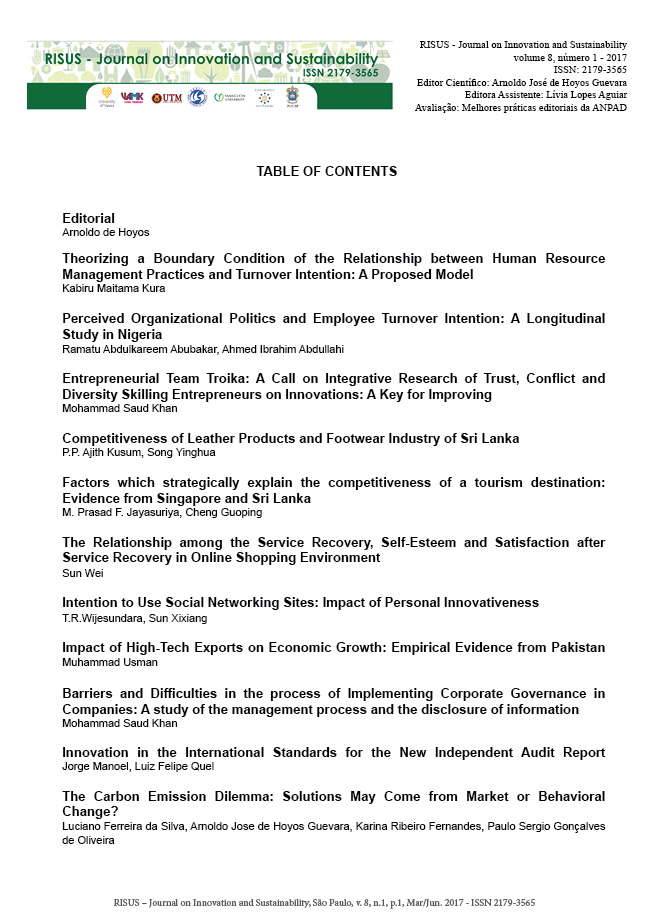Competitividade da Indústria de Couro e Calçados de Sri Lanka
DOI:
https://doi.org/10.24212/2179-3565.2017v8i1p32-54Palavras-chave:
Inovações, Tecnologia, Competividade, HablidadesResumo
Este trabalho explora a relação entre as habilidades dos empresários de produtos de couro e indústria de calçados no Sri Lanka e o envolvimento dos empreendedores de inovações em produtos, processos, matérias-primas e o mercado na indústria. Além disso, a pesquisa analisa a competitividade e inovação das empresas na indústria. Um banco de dados dessas empresas na indústria do Sri Lanka Industrial Development Board foi usado para elaborar um questionário entre as empresas. Realizaram-se entrevistas pessoais bem como por correspondência que juntas proporcionaram uma taxa de resposta acima da média dos questionários preenchidos utilizados para análise. A pesquisa mostrou que há uma forte ligação entre as habilidades dos empreendedores e seu envolvimento em inovações; e que o foco do empreendedor está mais em inovações de produto em vez de processo, matéria-prima e inovações de mercado, devido ao seu baixo nível de educação geral e o fato que o principal modo de aquisição de competências continua a ser no trabalho de formação. O uso da tecnologia foi encontrado ser de nível baixo o que tem um efeito negativo em inovações; no entanto, os empresários têm uma atitude positiva em relação às inovações que as agências relevantes podem capitalizar para a expansão da indústria e aumentar a competitividade. A pesquisa revela uma visão inteligente de que, em uma economia voltada para a eficiência, o que importa é a produtividade, onde promover a habilidade dos empreendedores produzirá resultados enormes para aproveitar o potencial dessa indústria em constante crescimento.Downloads
Publicado
Edição
Seção
Licença
Esta obra está licenciada sob uma licença Creative Commons Atribuição - No comercial - Sin derivaciones 4.0 Internacional
1.O(s) autor(es) autoriza(m) a publicação do artigo na revista;
2.O(s) autor(es) garante(m) que a contribuição é original e inédita e que não está em processo de avaliação em outra(s) revista(s);
3.A revista não se responsabiliza pelas opiniões, ideias e conceitos emitidos nos textos, por serem de inteira responsabilidade de seu(s) autor(es);
4.É reservado aos editores o direito de proceder ajustes textuais e de adequação do artigos às normas da publicação.
1.1 Copyright Statement
This journal is licensed under a Creative Commons Attribution-Non Commercial-No Derivers 4.0 International license.
1. The author (s) authorize the publication of the article in the journal;
2. The author (s) warrant that the contribution is original and unpublished and is not in the process of being evaluated in other journal (s);
3. The journal is not responsible for the opinions, ideas and concepts emitted in the texts, as they are the sole responsibility of its author (s);
4. The editors are entitled to make textual adjustments and to adapt the articles to the standards of publication.


